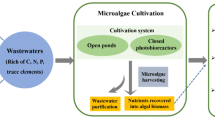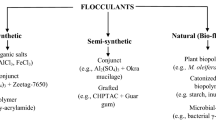Abstract
We developed a cell suspension culture system for zedoary (Curcuma zedoaria Roscoe), using 100 g fresh weight inoculum in a batch culture. The maximum cell biomass of 68.46 g/L fresh weight was obtained after 14 days of culture in a 10 L bioreactor with a pitch-blade impeller maintained at an agitation speed of 150 rpm and an aeration rate of 2.5 L/min. The accumulation of sesquiterpenes and polysaccharide in zedoary cells from 2 to 18 days was measured by HPLC and a phenol-sulfuric acid assay, respectively. The total polysaccharide concentration increased between 2 to 10 days of culture and reached a maximum value of 6.55%. HPLC revealed several eluted peaks of sesquiterpenes, which increased in amplitude from days 2 to 10. Furthermore, our results indicated that biotransformation occurred in the cell suspension, transforming certain sesquiterpenes into other types during culture.
Similar content being viewed by others
References
Maeda, H., N. Sunagane, and K. Kubota (1984) Pharmacological effects of the powder from Curcuma zedoaria on the gastrointestinal tract of experimental animals. Yakugaku Zasshi 104: 640–643.
Ruby, A. J., G. Kuttan, K. D. Babu, K. N. Rajasekharan, and R. Kuttan (1995) Anti-tumor and antioxidant activity of natural curcuminoids. Cancer Lett. 94: 79–83.
Limtrakul, P., S. Lipigorngoson, O. Namwong, A. Apisariyakul, and F. W. Dunn (1997) Inhibitory effect of dietary curcumin on skin carcinogenesis in mice. Cancer Lett. 116: 197–203.
Srivastava, K. C., A. Bordia, and S. K. Verma (1995) Curcumin, a major component of food spice turmeric, inhibits aggregation and alters eicosanoid metabolism in human blood platelets. Prostaglandins Leukot Essent Fatty Acids 52: 223–227.
Kim, K. I., J. W. Kim, B. S. Hong, D. H. Shin, H. Y. Cho, H. K. Kim, and H. C. Yang (2000) Antitumor, genotoxicity and anticlastogenic activities of polysaccharide from Curcuma zedoaria. Mol. Cells 10: 392–398.
Kim, K. I., K. S. Shin, W. J. Jun, B. S. Hong, D. H. Shin, Y. C. Hong, H. I. Chang, S. M. Yoo, and H. C. Yang (2001) Effects of polysaccharides from rhizomes of Curcuma zedoaria on macrophage functions. Biosci. Biotechnol. Biochem. 65: 2369–2377.
Furita, Y. and M. Tabata (1987) Secondary metabolites from plant cells: pharmaceutical application and progress in commercial production. pp. 169–185. In: C. E. Green, D. A. Somers, W. P. Hackett, and D.D. Biesboer (eds.). Plant Tissue and Cell Culture. Alan R Liss, NY, USA.
Furita, Y. (1988) Shikonin: Production by plant (Lithospermum erythrorhizon) cell cultures. pp. 225–236. In: Y. P. S. Bajaj (ed.). Biotechnology in Agriculture and Forestry: Medicinal and Aromatic Plants. Springer-Verlag, Berlin, Germany.
Ushiyama, K. (1991) Large scale culture of ginseng. pp. 92–98. In: A. Komamine, M. Misawa, and F. DiCosmo (eds.). Plant Cell Culture in Japan. CMC, Tokyo, Japan.
Schlatmann, J. E., A. M. Nuutila, W. M. Van Gulik, H. J. G. Ten Hoopen, R. Verpoorte, and J. J. Heijnen (1993) Scale-up of ajmalicine production by plant cell cultures of Catharanthus roseus. Biotechnol. Bioengin. 41: 253–262.
Sato, K., M. Nakayama, and J. I. Shigeta (1996) Culturing conditions affecting the production of anthocyanin in suspended cell cultures of strawberry. Plant Sci. 113: 91–98.
Seki, M., C. Ohzora, M. Takeda, and S. Furusaki (1997) Taxol (Paclitaxel) production using free and immobilized cells of Taxus cuspidata. Biotechnol. Bioeng. 53: 214–219.
Noble, R. L. (1990) The discovery of the vinca alkaloids-chemotherapeutic agents against cancer. Biochem. Cell Biol. 68: 1344–1351.
Loc, N. H., D. T. Duc, T. H. Kwon, and M. S. Yang (2005) Micropropagation of zedoary (C. zedoaria Roscoe)-a valuable medicinal plant. Plant Cell Tiss. Organ Cult. 81: 119–122.
Murashige, T. and F. Skoog (1962) A revised medium for rapid growth and bioassays with tobacco tissue culture. Physiol. Plant 15: 473–497.
Loc, N. H., T. T. T. Ha, and Y. Hirata (2006) Effect of several factors on cell biomass production of zedoary (C. zedoaria Roscoe) in bioreactor. Vietnamese J. Biotechnol. 4: 213–220.
Jang, M. K., D. H. Sohn, and J. H. Ryu (2004). A curcuminoid and two sesquiterpenoids from Curcuma zedoaria as inhibitors of nitric oxide synthesis in activated macrophages. Arch. Pharm. Res. 27:1220–1225.
Sun, Y. L., J. Tang, X. H. Gu, and D. Y. Li (2005) Watersoluble polysaccharides from Angelica sinensis (Oliv.) Diels: Preparation, characterization, and bioacitivity. Int. J. Biol. Macromol. 36: 283–289.
Chaplin, M. F. and J. F. Kennedy (1994) Carbohydrate Analysis. A Practical Approach. 2nd ed., pp. 143–204. Oxford University Press, Oxford, UK.
Li, X. L. and A. G. Zhou (2007) Preparation of polysaccharides from Acanthopanax senticosus and its inhibition against irradiation-induced injury of rat. Carbohydr. Polymers 67: 219–226.
Zhao, J. and R. Verpoorte (2007) Manipulating indole alkaloid production by Catharanthus roseus cell cultures in bioreactors: From biochemical processing to metabolic engineering. Phytochem. Rev. 6: 435–457.
Eibl, R. and D. Eibl (2008) Design of bioreactors suitable for plant cell and tissue cultures. Phytochem. Rev. 7: 593–598.
Ah, T., N. Ma, and R. Zaiton (2004) Multiplication of oil palm suspension cultures in a bench-top (2L) bioreactor. J. Oil Palm Research 16: 44–49.
Pavlov, A. I., M. I. Georgiev, I. N. Panchev, and M. P. Ilieva (2005) Optimization of rosmarinic acid production by Lavandula vera MM plant cell suspension in a laboratory bioreactor. Biotechnol. Prog. 21: 394–396.
Mantzouridou, F., T. Roukas, and P. Kotzekidou (2002) Effect of the aeration rate and agitation speed on β-carotene production and morphology of Blakeslea trispora in a stirred tank reactor: Mathematical modeling. Biochem. Engin. J. 10: 123–135.
Chattoppadhyay, S., A. K. Srivastava, S. S. Bhojwani, and V. S. Bisaria (2002) Production of podophyllotoxin by plant cell cultures of Podophyllum hexandrum in bioreactor. J. Biosci. Bioengin. 93: 215–220.
Nahar, L. and S. D. Sarker (2007) Phytochemistry of the genus Curcuma. pp. 71–106. In: P.N. Ravindran, K.N. Babu, and K. Sivaraman (eds.). Turmeric-The genus Curcuma. CRC Press, Taylor and Francis Group, USA.
Sakui, N., M. Kuroyanagi, Y. Ishitobi, M. Sato, and A. Ueno (1992) Biotransformation of sesquiterpenes by cultured cells of Curcuma zedoaria. Phytochem. 31: 143–147.
Author information
Authors and Affiliations
Corresponding author
Rights and permissions
About this article
Cite this article
Loc, N.H., Tuan, V.C., Binh, D.H.N. et al. Accumulation of sesquiterpenes and polysaccharides in cells of zedoary (Curcuma zedoaria Roscoe) cultured in a 10 L bioreactor. Biotechnol Bioproc E 14, 619–624 (2009). https://doi.org/10.1007/s12257-009-0013-3
Received:
Accepted:
Published:
Issue Date:
DOI: https://doi.org/10.1007/s12257-009-0013-3




